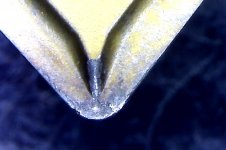Pete F
Titanium
- Joined
- Jul 30, 2008
- Location
- Sydney, Australia
I'm currently turning some 4140 HT from 22 mm to 10 mm with live centre support at around 100 m/min, DOC 1 mm, can't tell you the feed rate. I've tried various inserts including cermet but am getting terrible insert life, indeed the cermet seems to be worst of all with chipping damage. At 10 mm it is then gets threaded, and the threading insert seems to be holding up ok, but that's at quite low speed as this is all on a manual lathe.
I wonder what sort of insert life I should be getting, as this is getting ridiculous. I'm thinking of trying HSS as at least I can regrind the edge when it's trashed. I'm going through about 1 insert per piece at the moment!
The chips depend on the insert used, but are generally coming off ok, though I'm having issues keeping heat out of the work. The finish is good, though oddly enough the cermet didn't do as well. I've settled on a coated insert, I'd have to check the grade. The chips are definitely affecting the coating however.
I wonder what sort of insert life I should be getting, as this is getting ridiculous. I'm thinking of trying HSS as at least I can regrind the edge when it's trashed. I'm going through about 1 insert per piece at the moment!
The chips depend on the insert used, but are generally coming off ok, though I'm having issues keeping heat out of the work. The finish is good, though oddly enough the cermet didn't do as well. I've settled on a coated insert, I'd have to check the grade. The chips are definitely affecting the coating however.





